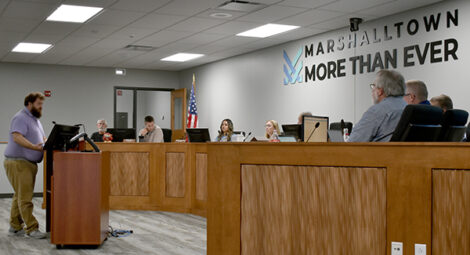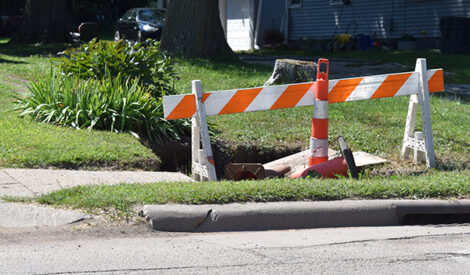Council moves forward with joining Middle Iowa Watershed Management Authority

T-R PHOTO BY ROBERT MAHARRY Middle Iowa Watershed Management Authority representatives Kasey Hutchinson, left, and Stephen Beck, right, address the Marshalltown city council during Monday night’s meeting.
The Marshalltown city council welcomed a pair of representatives from the Middle Iowa Watershed Management Authority — Kasey Hutchinson from Johnson County Planning and Development and Belle Plaine City Administrator Stephen Beck — to explain the consortium’s operations and makeup while inviting the city to become a member.
In simple terms, Hutchinson said a watershed management authority is a 28E agreement between two or more governmental organizations — cities, counties and soil and water conservation districts — with the goal of allowing for collaborative efforts on watershed improvements across jurisdictional boundaries. The first Watershed Management Authority (WMA) in Iowa was established in 2012, and there are currently 28 across the state.
Some of the basic activities WMAs generally undertake include drafting a watershed management plan, providing opportunities for public education and collaborating on funding opportunities for grants from the state and federal governments.
Hutchinson said discussions around the Middle Iowa River WMA started back in 2022, and they hosted an informational meeting in Tama that year with a strong turnout and enthusiasm. The organization was officially formed in 2023 with six charter members, and in 2024, they received an Iowa DNR Comprehensive Water Quality Planning Grant. Paired with a local match through American Rescue Plan Act (ARPA) dollars, the MIWMA received $221,000 and kicked off the planning process in July 2024 with Houston Engineering retained as a consultant.
As part of that plan, members sought to identify four priority subwatersheds at the Hydrologic Unit Code (HUC)-12 scale, the smallest cataloguing unit the United States Geological Survey (USGS) recognizes, and one of them is Asher Creek located just north of Marshalltown. From there, they can drill down on identifying issues within the watershed, setting goals for improvement and figuring out how to achieve them.
“The idea is that the plan will work for everybody who’s involved. It’s more generally formatted. Hopefully it provides relevant resources to also put communities in a good place to actually be ready for funding when it becomes available,” Hutchinson said.
More information can be found at https://middleiowawma.org/, and upcoming events are planned in Grinnell and at the Meskwaki Settlement next month. Beck, who serves as the vice chair of the MIWMA, then took over for Hutchinson and provided some background both on watersheds and how he became involved at a time when Belle Plaine was in a severe drought.
“As we were losing water faster and faster and struggling, our coalition really kind of wrapped its arms around my community and helped us find resources with (the) Iowa Department of Ag and Land Stewardship, the DNR, Homeland Security, Army Corps of Engineers, all of these different places that I have become very familiar with now,” he said. “It was a very humbling experience and scary to go through, but we made it and we’re working on plans and things like that. I would’ve never met Kasey if we wouldn’t have had this group put together, and we are hopeful that Marshalltown will join in our quest for water and soil quality and conservation and flood protection and drought resiliency, and we know Carol (Webb) has a lot of background in that. And we’ve talked, and I’m excited to work with her hopefully.”
Mayor Pro Tem Mike Ladehoff then asked Webb what she needed from the council, and she responded that she would like direction to bring back a formal 28E agreement as the item was only on the agenda for discussion. After a motion and second were made, the floor was opened up to public comment.
“I just want to affirm how important it is for Marshalltown to engage in this kind of regional watershed planning. Flooding, water quality, drainage, like Kasey said, is not limited to our city limits. We are part of a larger ecosystem, especially this watershed where we are so close to the head of it. What we do affects a lot of people downstream,” Erin Carpenter said. “I would encourage the city to also re-engage our stormwater advisory committee, which hasn’t met in some time. There’s value in coordinating our local perspectives with regional planning.”
Jolene Ballard thought it might be helpful to clarify the location of Asher Creek, and Lonnie Hogeland commended the speakers for their high level of knowledge on the subject before encouraging the city to get involved and ensure that residents are drinking good water.
As a salvage yard owner, Hogeland said he deals with all sorts of government agencies and regulations, and he reiterated the importance of working with the experts to keep the water supply clean.
The original motion passed by a unanimous 7-0 tally.
——
Contact Robert Maharry
at 641-753-6611 ext. 255 or
rmaharry@timesrepublican.com.




